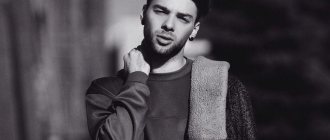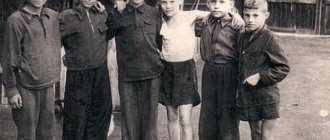Wikipedia has articles about other people with this surname, see Bianchi; Bianchi, Vitaly.
| Vitaly Bianchi | |
| Date of Birth | January 30 (February 11) 1894[1] |
| Place of Birth |
|
| Date of death | June 10, 1959(1959-06-10)[2][3](age 65) |
| A place of death |
|
| Citizenship (nationality) |
|
| Occupation | writer, children's writer, journalist, ornithologist, naturalist |
| Years of creativity | 1923—1954 |
| Genre | children's literature |
| Language of works | Russian |
| Works on the website Lib.ru | |
| Works on Wikisource | |
Vitaly Valentinovich Bianki
(January 30 [February 11] 1894[1], St. Petersburg[2] - June 10, 1959(1959-06-10)[2][3], Leningrad[2]) - Soviet writer, author of many works for children .
Biography
His father, Valentin Lvovich Bianki (1857-1920), was a scientist and worked in the ornithological department of the Zoological Museum of the Academy of Sciences[4]. It is known that the Bianchi family appeared in Russia at the beginning of the 19th century. One branch of the family had Italian-Swiss roots, the other - German. Vitaly's great-grandfather was a famous opera singer. Before a tour of Italy, at the request of his impresario, he changed his German surname Weiss (German weiß means white) to Bianchi (Italian bianco also means white)[5].
He entered the natural sciences department of the Faculty of Physics and Mathematics of Petrograd University[6].
In his youth, he played on football teams in St. Petersburg in city championship games[7]. He played for the clubs “Petrovsky” (1911), “Neva” (1912), “Unitas” (1913-1915, 1916 spring). Winner of the Spring Cup of St. Petersburg in 1913.
In February 1916, he married the daughter of a titular councilor, Zinaida Aleksandrovna Zakharevich[8].
In 1916, Bianchi was drafted into the army. After completing accelerated courses at the Vladimir Military School with the rank of warrant officer, he was sent to an artillery brigade.
In February 1917, the soldiers elected him to the Council of Soldiers' and Workers' Deputies. He joined the Socialist Revolutionary Party. He was a member of the commission for the protection of artistic monuments of Tsarskoe Selo. In the spring of 1918, together with his unit, he ended up on the Volga. In the summer of 1918, Bianchi began working for the Samara newspaper “People” (published from September to December 1918 by the Agitation Cultural and Educational Department of the Socialist Revolutionary Komuch).
In connection with the offensive of the Red Army, Bianchi was evacuated from Samara and lived for some time in Ufa, Yekaterinburg, then again in Ufa, then in Tomsk and finally settled in Biysk[9].
Here he was mobilized into Kolchak's army. After desertion, he hid under someone else's name[6]. At this time he was Vitaly Belyanin, a student at Petrograd University and an ornithologist-collector at the Zoological Museum of the Russian Academy of Sciences. The double surname Bianchi-Belyanin remained with him until the end of his life.
After the establishment of Soviet power in Biysk, Bianki began working in the department of public education in the museum department. Working in the department of public education, he was appointed head of the museum. Later he also became a teacher at the school named after the Third Comintern.
Bianchi was an active participant in the Biysk Society of Nature Lovers and gave lectures on ornithology at the Altai People's University. While living in Biysk, he organized two scientific expeditions to Lake Teletskoye.
By the end of 1920, his first marriage had broken down. In Biysk, Bianki worked at a second-level school (formerly a gymnasium) as a biology teacher. There he met a teacher of French and German, Vera Nikolaevna Klyuzheva. On May 6, 1921, Vitaly Bianki and Vera Nikolaevna registered their marriage, and on the 13th of the same month they got married in a local church[4].
In 1921, Biyska was arrested twice, and also served three weeks in prison as a hostage. In September 1922, V. Bianchi was warned about a possible arrest, and, having arranged a business trip, went with his family to Petrograd.
In 1923, in the magazine “Sparrow”, he published his first story, “The Journey of the Red-Headed Sparrow”[9], and then published the book “Whose Nose is Better?”[10].
At the end of 1925, Bianchi was arrested again and sentenced for participation in a non-existent underground organization to three years of exile in Uralsk. In 1928, thanks to numerous petitions, including from M. Gorky, who turned to G. G. Yagoda, he received permission to move to Novgorod, and then to Leningrad. A new arrest followed in November 1932. After three and a half weeks he was released “for lack of evidence.”
In March 1935, Bianchi, as “the son of a personal nobleman, a former Social Revolutionary, an active participant in the armed uprising against Soviet power,” was once again arrested and sentenced to exile for five years in the Aktobe region [9]. Thanks to the intercession of E.P. Peshkova, the exile was canceled and Bianchi was released. From 1924 to June 10, 1959 (except for exile and evacuation) he lived in Leningrad at the address - Vasilyevsky Island, Maly Prospekt, building 4
.
In these years before the war, V. Bianchi organized a “literary school” at his home in Leningrad. The students of the school were Nikolai Sladkov, Alexey Liverovsky, Zoya Pirogova, Kronid Garnovsky, Svyatoslav Sakharnov, Boris Zhitkov and others, who later became famous writers. V.V. Bianchi became the leader and mentor of the famous breeder scientist and aspiring writer N. Pavlova[11]. Vitaly Valentinovich treated this responsibility conscientiously. Before meeting with her, I carefully prepared, made many comments, explained the forms of plot development, how to correctly begin and end a work, and how to reflect time in an essay. With the help of Vitaly Valentinovich Bianchi, the writer wrote her first story, “Record Shot” (1935). Nina Mikhailovna Pavlova sent new literary works to Bianchi by mail for editing, and sometimes brought him manuscripts. Bianchi read and edited them. During her illness (acute articular rheumatism), V.V. Bianchi’s letters were a great support for her. In his ninth lifetime edition of the book “Forest Newspaper,” V. Bianchi published 28 stories by N. Pavlova.
During the Great Patriotic War, V. Bianchi was not drafted into the army due to heart disease, was evacuated to the Urals, then returned to Leningrad[9].
In the last years of his life he was seriously ill. In 1949 he suffered a heart attack, then two strokes. Systemic vascular disease caused severe pain in his legs, almost completely depriving him of the ability to walk. In the 50s, he participated in the monthly children's radio program “News from the Forest”[12]. On June 10, 1959, Vitaly Valentinovich Bianchi died. He was buried at the Bogoslovskoe cemetery. The tombstone by the sculptor Germaine Mellup[13] is included in the List of objects of historical and cultural heritage of federal (all-Russian) significance[14].
Biography of Vitaly Bianchi for children
“There is a certain cheerful force living inside me. I see: everything that I had and still have that is good and bright in life... comes from this power. She is blessed both in me and in others - in people, birds, flowers and trees, in the earth and in the water,” Vitaly Bianchi wrote in his diary.
Bianchi's love for nature and interest in science developed in childhood. Vitaly Bianki was born in 1894 in St. Petersburg, in the family of an ornithologist, curator of the collections of the Zoological Museum of the Russian Academy of Sciences, Valentin Lvovich Bianki. An ornithologist is a scientist who studies birds. Bianchi's apartment was located directly opposite the museum where the boy's father worked. The children - three sons - often visited the halls of this museum. There was a real museum in the apartment itself where the Bianchi family lived: numerous cages with birds from floor to ceiling, an aquarium with fish, a terrarium with turtles, lizards and snakes.
In the summer, Bianchi’s family went to the village of Lebyazhye. Here Vitaly went on a real forest journey for the first time. He was then 5-6 years old. Since then, the forest has become a magical land for him. Father constantly took little Vitaly with him into the forest, telling him about every bird and animal. Bianchi kept the tradition of spending summers in nature, in the countryside, throughout his life.
Vitaly studied at the gymnasium, then at the Faculty of Natural Sciences at the university, served in the army, and later worked as a teacher at school. And Vitaly Bianchi always considered his father to be HIS main forest teacher. It was he who taught his son to write down all his observations. In numerous notebooks, Bianchi kept his notes on the habits of birds and animals, special local words, proverbs, hunting stories and stories of experienced people. Brother Anatoly, who traveled with him, often took photographs.
After many years, these observations were transformed into fascinating stories and tales about nature.
Vitaly Bianki wrote: “Forest houses”, “Whose nose is better?”, “Mouse Peak”, “Teremok”, “How the ant hurried home”, “Patch” and many others. The writer’s work on his main book, “Forest Newspaper,” began in 1928 and continued until 1958—a whole 30 years—ten editions of which were constantly supplemented and changed by the writer himself and were published during his lifetime.
Most of Bianchi's stories are dedicated to the forest, which he knew well since childhood. Bianchi's works teach us to love nature and treat it with care, observe animals and be ready to always come to the aid of the weak.
The radio program “News from the Forest” brought Bianchi great creative success, which lasted for many years and was very much loved by listeners, on which he worked together with his students. The writer's last book, Bird Identifier in the Wild, remained unfinished. Vitaly Valentinovich Bianchi died in 1959, when he was 65 years old.
Literary activity
Bianca's books reveal the world of nature and teach us to penetrate its secrets. The language is light and colorful, appealing directly to the child’s imagination.
"Forest newspaper for every year"
(1st ed., 1928)[18] has an original literary form: using newspaper techniques - telegram, chronicle, advertisement, feuilleton - a calendar of forest life is given for each month. It has twelve chapter numbers - one for each month. The year begins with the vernal equinox, the 1st month - from March 21 to April 20, and so on. “Lesnaya Gazeta” grew out of the “newspaper department” of the “New Robinson” magazine, where Bianchi kept a phenological calendar of nature from issue to issue. During the author's lifetime, Lesnaya Gazeta was expanded and republished many times (9th ed., 1958). An image of the cover of the book “Forest Newspaper” of 1949 and a mention of the author’s name are in the text of the TSB 2nd edition[19]. Currently (2000s) it is usually published in abridged form.
Basically, Bianchi discovered his native nature at his dacha in Lebyazhye. Representatives of the scientific community of St. Petersburg often gathered at the dacha.
Bianchi wrote more than three hundred stories, fairy tales, novellas and articles, published 120 books, which were printed with a total circulation of 40 million copies. In the Soviet Union, Bianchi's books were widely used in kindergartens and elementary schools.
Bianchi played a significant role in the fate of the children's writer S.V. Sakharnov. Sakharnov considered Bianchi his teacher. N.I. Sladkov is also a student and follower of Bianchi.
Here are some of his works for children:
- Pansy duck
- Water horse
- Where do crayfish spend the winter?
- Eyes and ears
- Green Pond
- Like an ant hurrying home
- How I wanted to pour salt on the hare's tail
- Red hill
- Who sings what?
- Kuzyar the Chipmunk and Inoika the Bear
- Cuckoo
- Forest houses
- Forest Scouts
- Lyulya
- Max
- Mouse Peak
- Heavenly elephant
- Orange neck
- First hunt
- Sundew - mosquito death
- Fish House (co-authored with Anna Akimkina)
- Snow book
- Owl
- Teremok
- Terenty-grouse
- Tails
- Whose nose is better?
- Whose legs are these?
Biography and books of the author Bianki Vitaly Valentinovich
Vitaly Valentinovich Bianchi is an outstanding Russian writer and author of popular children's works. Bianchi's works are excellent material for reading, raising and developing children.
Born in St. Petersburg on January 30 (February 11), 1894. The writer had German-Swiss roots. His father was an entomologist at the Zoological Museum of the Academy of Sciences. The writer's great-grandfather was an outstanding opera singer. On one of his Italian tours, he changed his surname Weiss (from German “white”) to Bianchi (from Italian “white”). Vitaly was educated at Petrograd University at the Faculty of Physics and Mathematics.
In his youth, he was fond of football and even participated in the St. Petersburg city championships. In 1916 he was drafted into the army, and a year later he joined the Socialist Revolutionary Party. Since 1918, Vitaly Bianki worked in the Social Revolutionary propaganda newspaper “People”. Soon he was mobilized by the Russian army, from where he deserted. The writer hid under the surname Belyanin, which is why he had a double surname until the end of his life. In the 1920-1930s, he was arrested more than once for participation in non-existent underground organizations. M. Gorky and his first wife E. P. Peshkova interceded for him.
Bianchi did not participate in the Great Patriotic War due to developing heart disease. In 1949, he suffered a heart attack and then two strokes. The writer's work had an original literary form. The first story, "The Journey of the Red-headed Sparrow", appeared in 1923. It was followed by the book “Whose nose is better?” In his works, he revealed the world of nature and taught how to penetrate its secrets. All of Bianca's stories were written in easy and colorful language, accessible primarily to children.
Most of Bianchi's works are dedicated to the forest, which he knew well since childhood. Writer N.I. Sladkov speaks of him as a “discoverer,” and the author himself calls himself a “translator from the wordless.” Many of Bianchi’s stories affirm the idea of the vital practical importance of knowledge of nature, the ability to observe it and navigate it (“Following the Footsteps”, “How Uncle Volov Searched for Wolves”, “Tender Lake Sarykul”, “Ghost Lake”, etc.) Before us is not a boring moralizer, but a master of a plot story, dynamic, intense, with an unexpected turn of events (the mystery story “The Fatal Beast”, the adventure story “Mouse Peak”, the “biographical” description of the animal “On the Great Sea Route”, etc.) At the same time, they contain enormous educational material that is easily absorbed by the child.
One of the innovations was the “Forest Newspaper for Every Year,” first published in 1928. It was a kind of calendar of forest life. The writer had a dacha in the Lebyazhy village, where he loved to gather the scientific society of St. Petersburg. During his life, he wrote more than three hundred stories, fairy tales, novellas, 120 books, etc. Bianchi's works were widely used in kindergartens and primary schools in the USSR. His followers were S.V. Sakharnov and N.I. Sladkov.
V.V. Bianchi died on June 10, 1959 in Leningrad.
Memory
2 rubles 2020, silver Russian postal envelope
- The name of V.V. Bianki was given to the Biysk Museum of Local Lore.
- Streets in the cities of Moscow, Veliky Novgorod, Rostov-on-Don, Osa, Borovichi, and the village of Charyshskoe are named in his honor.
- Many public children's libraries are named after V.V. Bianki (in Novosibirsk, Moscow, Nizhny Novgorod, Veliky Novgorod, Perm).
- In July 2008, using voluntary donations from residents in memory of Bianki, in the coastal strip of the Gulf of Finland, on the territory of the village of Lebyazhye with a total area of 20.1, the protected natural landscape “Polyana Bianki” was created - the first municipal protected area in Russia[20].
- On January 9, 2020, the Bank of Russia issued a commemorative silver coin with a face value of 2 rubles “Writer V.V. Bianchi, on the 125th anniversary of his birth (02/11/1894)" in the series "Outstanding Personalities of Russia"[21].
- In 2020, for the 125th anniversary of the birth of Vitaly Bianchi, a postal artistic stamped envelope and a special stamp were issued.
Bianki Vitaly Valentinovich
Vitaly Bianki was born in St. Petersburg. He got his melodious surname from his Italian ancestors. Perhaps they also have an enthusiastic, artistic nature. From his father, an ornithologist, he got a talent for research and an interest in everything “that breathes, blooms and grows.”
Vitaly Bianki photography
My father worked at the Zoological Museum of the Russian Academy of Sciences.
The collection curator's apartment was located directly opposite the museum, and the children - three sons - often visited its halls. There, behind glass display cases, frozen animals were brought from all over the globe. How I wanted to find a magic word that would “revive” the museum animals. There were real houses: a small zoo was located in the keeper’s apartment. Advertising:
In the summer, Bianchi’s family went to the village of Lebyazhye. Here Vitya first went on a real forest journey. He was then five or six years old. Since then, the forest has become a magical land for him, a paradise.
His interest in forest life made him a passionate hunter. No wonder he was given his first gun at the age of 13. He also loved poetry very much. At one time he was fond of football, even being a member of the gymnasium team.
The interests were different, and education was the same.
At first - a gymnasium, then - the Faculty of Natural Sciences at the university, and later - classes at the Institute of Art History. And Bianchi considered his father to be his main forest teacher. It was he who taught his son to write down all his observations. After many years, they were transformed into fascinating stories and fairy tales.
Bianchi never attracted observations from the window of a cozy office. All his life he traveled a lot (though not always of his own free will). I especially remember the hikes in Altai. Bianki then, in the early 20s, lived in Biysk, where he taught biology at school and worked in the local history museum.
In the fall of 1922, Bianchi and his family returned to Petrograd. In those years, in the city, at one of the libraries, there was an interesting literary circle, where writers who worked for children gathered. Chukovsky, Zhitkov, Marshak came here. Marshak once brought Vitaly Bianchi with him. Soon his story “The Journey of the Red-Headed Sparrow” was published in the magazine “Sparrow”.
Best of the day
| John Argyropoulos Visits:274 | Polina Vitorgan Visited:271 | The last Russian emperor Visited: 265 |
In the same year, 1923, the first book (“Whose nose is better”) was published.
Bianchi's most famous book was The Forest Newspaper. There was simply no other one like it. All the most curious, most unusual and most ordinary things that happened in nature every month and day found their way onto the pages of the Lesnaya Gazeta. Here one could find an announcement by starlings “We are looking for apartments,” or a message about the first “peek-a-boo” sounded in the park, or a review of the performance that the great grebe birds gave on a quiet forest lake. There was even a criminal chronicle: trouble in the forest is not uncommon. The book “grew” from a small magazine section.
Bianchi worked on it from 1924 until the end of his life, constantly making some changes. Since 1928, it has been reprinted several times, become thicker, and been translated into different languages of the world. Stories from Lesnaya Gazeta were heard on the radio and published, along with other works by Bianchi, on the pages of magazines and newspapers.
Bianchi not only constantly worked on new books (he is the author of more than three hundred works), he managed to gather around him wonderful people who loved and knew animals and birds. He called them “translators from the wordless.” These were N. Sladkov, S. Sakharnov, E. Shim. Bianchi helped them work on their books.
Together they hosted one of the most interesting radio programs, “News from the Forest.”
Bianchi wrote about the forest for thirty-five years. This word often appeared in the titles of his books: “Forest Houses”, “Forest Scouts”. Bianchi's stories, short stories, and fairy tales uniquely combined poetry and accurate knowledge. He even called the latter in a special way: non-fairy tales. They don't have magic wands or walking boots, but there are no less miracles there. Bianchi could talk about the most unprepossessing sparrow in such a way that we are only surprised: it turns out that he is not at all simple. The writer managed to find the magic words that “disenchanted” the mysterious forest world.
Simon
sucks 02/11/2007 07:03:45
I've never seen anything like this anywhere!!!!!!!!!!!!!!!!!!!!!!
Best weeks
| Rich and famous Visits: 996 | A man's beard decorates him Visited: 1064 | Margaret Douglas Visits:1005 |
Notes
- ↑ 1 2 German National Library, Berlin State Library, Bavarian State Library, etc.
Record #119458659 // General regulatory control (GND) - 2012-2016. https://wikidata.org/Track:Q27302″>https://wikidata.org/Track:Q304037″>https://wikidata.org/Track:Q256507″>https://wikidata.org/Track:Q170109 ″>https://wikidata.org/Track:Q36578″> - ↑ 123456
Bianchi Vitaly Valentinovich // Great Soviet Encyclopedia: [in 30 volumes] / ed. A. M. Prokhorov - 3rd ed. - M.: Soviet Encyclopedia, 1969.https://wikidata.org/Track:Q17378135″>
- ↑ 12
BNF ID: Open Data Platform - 2011.https://wikidata.org/Track:Q19938912″>https://wikidata.org/Track:P268″>https://wikidata.org/Track:Q54837″>
- ↑ 1 2 Bianchi E.V.
“I would choose Altai...” (preface to the book by Bianchi V.V. “Amazing Secrets”). - How was the dynasty born? In memory of Valentin Bianchi. | Biographies | SchoolLife.ru
- ↑ 12
Olga Ushakova, “Great Writers”, Litres, 2020, ISBN:9785041399696 - Lukosyak Yu.P.
History of St. Petersburg football. - St. Petersburg: Union of Artists, 2011. - ISBN 978-5-8128-0111-3. - Metric record of the Church of the Methodius Shelter
- ↑ 1234
Who's who in the world, OLMA Media Group, 2003, ISBN: 9785812300883 - Encyclopedia. Around the world.
- Children's writer Nina Mikhailovna Pavlova
- Soviet society in memoirs and diaries. Volume 8. Literary life of the USSR, Litres, 2020, ISBN: 9785041757717
- Kobak, Piryutko: Historical cemeteries of St. Petersburg, 2011.
- BIANCHI Vitaly Valentinovich (1894-1959) (unspecified)
(inaccessible link). Retrieved March 3, 2020. Archived March 27, 2020. - ↑ 12
Grandson of the writer Vitaly Bianchi: “At home, in a city apartment, we lived with dogs, canaries and even a bat!” - com/people/%D0%9C%D0%B8%D1%85%D0%B0%D0%B8%D0%BB-%D0%90%D0%BB%D0%B5%D0%BA%D1%81% D0%B0%D0%BD%D0%B4%D1%80%D0%BE%D0%B2%D0%B8%D1%87-%D0%97%D0%B0%D1%85%D0%B0%D1 %80%D0%B5%D0%B2%D0%B8%D1%87/6000000024387415122 Mikhail Aleksandrovich Zakharevich (inaccessible link)
- ↑ 12
Dates of life are indicated on the tombstones at the Bogoslovskoye Cemetery in St. Petersburg. - Anna Boguminskaya, “Writers”, Litres, 11 juil. 2020, ISBN: 9785457737976
- TSB, 2nd edition, 1952, p. 150.
- Glade Bianki | Protected natural areas of Russia (unspecified)
. oopt.aari.ru. Retrieved May 30, 2020. - On the release into circulation of a silver coin with a face value of 2 rubles “Writer V.V. Bianki, on the 125th anniversary of his birth (02/11/1894)" series "Outstanding Personalities of Russia", Bank of Russia
Literature
- “Children’s literature” // Great Soviet Encyclopedia / B. A. Vvedensky (editor-in-chief). — 2nd ed. - M.: Great Soviet Encyclopedia, 1952. - T. 14 (“Demosthenes - Precambrian”). — 300,000 copies.
- Grodensky G.
Vitaly Bianchi. - M.-L., 1954; - Life and work of V. Bianchi. [Articles, memoirs, publications, letters]. - L., 1967.
- Cossack V.
Lexikon of Russian literature of the 20th century = Lexikon der russischen Literatur ab 1917 / [trans. with German]. - M.: RIK "Culture", 1996. - XVIII, 491, [1] p. — 5000 copies. — ISBN 5-8334-0019-8. - Lebedev Sun.
Vitaly Bianchi // Literary newspaper. - 1934. - May 10. ([article text]) - Alexander Valerievich Kobak, Yuri Minaevich Piryutko.
Historical burials at the Bogoslovskoye Cemetery // Historical cemeteries of St. Petersburg. — 2nd ed., revised. and corr. - M.: Tsentrpoligraf, 2011. - ISBN 978-5-227-02688-0.










